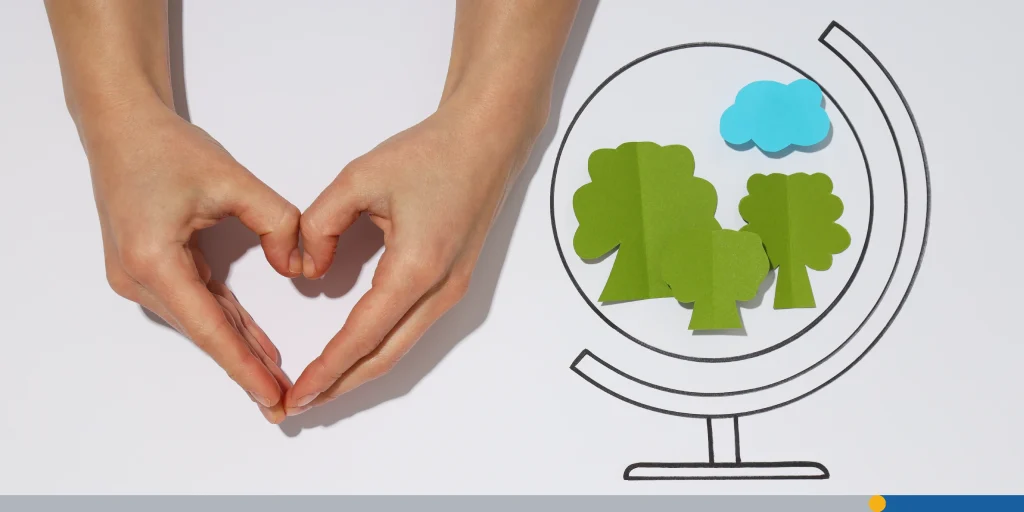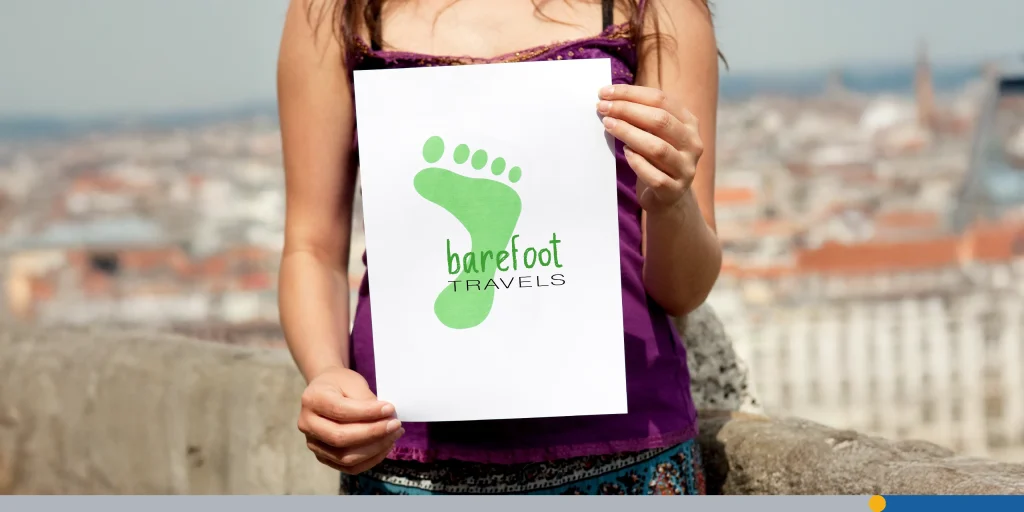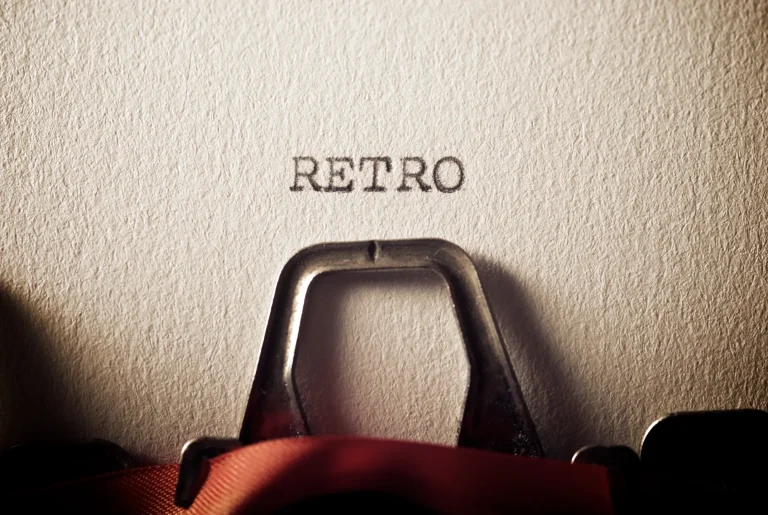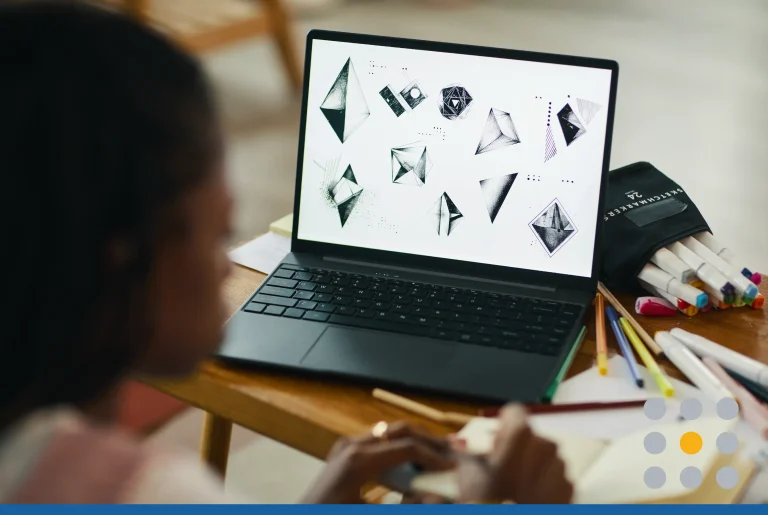Sustainability is a global issue that impacts everyone. If you’re a business owner, you can’t afford to neglect sustainability in every aspect of your operation, and that also means creating marketing materials and logos that promote eco-friendliness.
But you might be asking yourself, what exactly is an eco-friendly logo? It could be a leafy green emblem, a minimalist recycling symbol, or a soft earth-tone color palette. However, eco-friendly design extends far beyond simply making things appear green.
Today’s logos are about storytelling and communicating a brand’s commitment to sustainable practices, environmental responsibility, and reducing its carbon footprint.
Consumers today are more conscious of waste, pollution, and the impact of their purchases. In a 2020 McKinsey US consumer sentiment survey, more than 60% of respondents said they’d pay more for a product with sustainable packaging. The percentage is still very close today as well.
As this shift becomes more prevalent, businesses are rethinking how they present themselves to the world. Logos are at the forefront of this evolution. A strong eco-friendly logo can be a symbol of a business model aligned with environmental sustainability and ethical business practices.
In this article, we’ll do a deep dive into eco-friendly logo design trends, offering ideas, insights, and a look at how brands can use logos as powerful tools for sustainable branding.
- Why Eco-Friendly Logos Matter More Than Ever
- Key Trends in Environmentally-Friendly Logo Design
- Real-World Examples of Eco-Friendly Logo Design
- How to Create an Eco-Friendly Logo

Why Eco-Friendly Logos Matter More Than Ever
The environmental impact of businesses is no longer hidden. Customers, investors, and even governments are paying close attention to how companies manage emissions, waste, and sustainable sourcing.
Companies like Patagonia have been at the center of more environmentally conscious business practices. Since 1985, the company has pledged one percent of its sales to preserving and restoring the natural environment and, since 2002, has been part of a global network of firms committed to inspiring collective action and preventing greenwashing.
Greenwashing is when companies claim they have sustainable business practices but don’t. We’ll dive deeper into this topic later in the article.
When it comes to communicating your company’s dedication to environmental action, your logo (though small in size) carries big weight. It’s often the first impression customers get, and if designed thoughtfully, it can communicate your commitment to the planet.
An eco-friendly logo tells a story without words. It says:
- “We care about the environment.”
- “We’re committed to sustainability.”
- “Our business practices align with ethical and green initiatives.”
When done right, your logo can become a key part of your sustainable branding and set your company apart from greenwashing competitors.

Key Trends in Environmentally-Friendly Logo Design
While each logo is unique, there are some shared elements that pop up in many sustainable logo designs. Let’s go over some of the most common trends so that you can get some inspiration for your own logo design.
Minimalism Meets Sustainability
Less is more, especially in eco-friendly logos. Minimalist logos not only save space but also reduce the need for excessive materials in packaging and marketing campaigns. Clean lines, simple shapes, and uncluttered visuals communicate transparency and credibility.
Think of it this way: a minimalist logo reduces pollution in design. It avoids excess detail (which can look outdated quickly) and instead creates timeless, adaptable logos that align with sustainable practices.
Nature-Inspired Design
Leaves, trees, mountains, rivers, and the planet itself. These creative natural elements are finding their way into more and more logos. Businesses are leaning into symbols of nature because they instantly connect with environmentally conscious consumers.
A perfect example of this is the North Face logo, which was inspired by Half Dome, a mountain in Yosemite National Park. A subtle nod to the company’s roots in backpacking and a quest to reconnect with nature.
Using eco elements isn’t just aesthetic, it’s strategic. It reflects a commitment to protecting the environment and resonates with consumers who want their choices to have less environmental impact.
Earth-Friendly Color Palettes
An eco-friendly color palette usually includes green, earthy browns, ocean blues, and soft neutrals. These colors evoke trust, environmental sustainability, and eco-friendly practices. They’re also proven to influence customers’ perception. When consumers see green or earthy tones, they often associate them with sustainable products and ethical businesses.
More advanced design projects are experimenting with biodegradable inks or digital-first branding that reduces materials altogether, helping cut down on waste.
Recycled & Organic Typography
Typography is an integral part of your brand identity. Fonts inspired by recycled materials, hand-drawn lettering, or organic shapes are becoming more common. They appear raw, authentic, and relatable, making them perfect for brands that want to demonstrate transparency and accountability in their business practices.
These styles stand as an example of how creative choices in logo design can connect deeply with consumers who are tired of polished corporate looks.
Versatility & Digital-First Design
Since much of modern marketing happens online, companies are embracing logo design that works across digital platforms. A logo that looks great on social media requires fewer physical materials, which reduces emissions and waste from packaging and print campaigns.
This future-focused approach also means logos are scalable, adaptable, and ready to stand out in digital campaigns, which is a major plus for any sustainable business.

Logos That Tell a Story
Today’s eco-friendly logos often integrate hidden meanings or creative storytelling. For example, a logo may include a tree that doubles as a human figure, symbolizing the connection between human well-being and the environment. Others use negative space cleverly to highlight sustainable practices or fair trade values.
The result? A logo that isn’t just green in look but ethical in message.
The Business Case for Eco-Friendly Logos
The goal of creating an eco-friendly logo is to align your business goals with a devotion to sustainability. Here’s why it matters, and how this approach will help elevate your business in the long run:
- Brand reputation: A logo that reflects eco-friendly practices boosts your credibility and shows commitment to environmental responsibility.
- Customer loyalty: Today’s consumers are more likely to stay loyal to sustainable businesses that practice what they preach.
- Investor confidence: Investors increasingly fund companies that follow sustainability principles and minimize risk by avoiding pollution and regulatory fines.
- Regulatory compliance: With stricter environmental governance, your logo should reflect your commitment to following the rules.
- Profits and growth: Aligning with eco-values isn’t just ethical; it’s profitable. Global consumers are willing to pay more for sustainable products.
Avoiding Greenwashing in Logo Design
As we mentioned before, one of the biggest risks in eco-friendly branding is greenwashing, when companies pretend to be more sustainable than they are. Customers and investors are increasingly skeptical, and transparency is key.
If you want your eco-friendly design to be believable:
- Pair it with real eco-friendly practices like sustainable sourcing or fair trade.
- Show proof through research, reports, and initiatives.
- Be honest about where you are in your sustainability journey.
A logo can spark awareness, but accountability and action build lasting loyalty.

Real-World Examples of Eco-Friendly Logo Design
Here are some companies that have incorporated eco-friendly elements into their logos and have backed it up with actions supporting sustainability.
Patagonia
Known for its sustainable business model and environmental responsibility, Patagonia’s logo (a mountain silhouette) perfectly reflects its commitment to the outdoors. It’s simple, green in spirit, and aligned with its eco-friendly practices.
The Body Shop
The Body Shop uses logos and campaigns that emphasize fair trade, ethical sourcing, and sustainable products. Their designs are creative, natural, and unmistakably tied to their eco mission.
Tesla
Tesla’s logo isn’t overtly eco, but it symbolizes innovation in reducing emissions and creating a sustainable future. The sleek design reflects the business goals of cutting-edge, clean energy solutions.
Starbucks
Starbucks has shifted towards eco-friendly practices like biodegradable packaging and sustainable sourcing of coffee beans. Their iconic siren logo may not scream green, but the brand’s reputation is heavily tied to its environmental initiatives.

How to Create an Eco-Friendly Logo
Designing an eco-friendly logo is all about creating a symbol that connects your brand to its commitment toward environmental responsibility, while also resonating with customers, clients, and investors.
Whether you’re working with a designer or taking on a design project yourself, here are some expanded key principles to guide you:
1. Research First
Before sketching your first draft, dive into research. Look at your industry standards, check what your competitors are doing, and identify gaps where you can stand out.
For example, if most businesses in your space lean heavily on the color green, maybe you can take a different approach with ocean blues or earthy neutrals.
Also, think about your consumers’ expectations: are they more focused on reducing waste, supporting fair trade, or demanding transparency in sourcing? Understanding these nuances ensures your logo aligns with the real environmental challenges your audience cares about.
2. Choose Natural Colors
Color tells half the story in logo design. For eco-friendly logos, stick to a color palette inspired by nature. Think fresh greens, forest browns, sky blues, and sandy neutrals. But don’t stop there. You can also experiment with muted pastels or earthy textures that mimic recycled materials.
Using colors associated with the planet helps signal sustainability and eco-friendly practices instantly. Plus, natural colors often feel more authentic, helping you build credibility and avoiding the trap of over-polished, corporate-looking logos.

3. Think Minimalist
The fewer design elements you use, the easier it is to adapt your logo across packaging, digital platforms, and printed materials. A clean, adaptable logo reduces the need for excessive ink or complex printing processes, cutting down on both costs and carbon footprint. It also ensures your logo design looks timeless rather than chasing fads.
Remember: a strong logo should be recognizable in black and white, monochrome, small print, or even etched into biodegradable packaging.
4. Reflect Your Values
Your logo is a visual statement of your business goals and eco commitments.
If you’re a business working with fair trade farmers, consider weaving in subtle nods to agriculture or community. If you focus on reducing pollution and emissions, maybe incorporate clean lines that symbolize air, wind, or energy flow.
The key is subtlety. Avoid clichés like an overused recycling symbol unless you can reinvent them with creative flair.
5. Test with Consumers
A great logo doesn’t exist in a vacuum; it lives in the minds of customers. Once you have a few concepts, test them with your target audience. This could mean sharing mockups on social media, running surveys with clients, or even gathering feedback from investors.
Ask not only if they find the logo attractive, but also if it communicates your eco-friendly practices clearly.
6. Align with Actions
This might be the most important step: your logo can’t do all the work for you. An eco-friendly logo must be backed up by real sustainability initiatives.
If your brand showcases a leaf, make sure your business practices truly reduce waste or support green marketing campaigns. Transparency is key; if you don’t walk the talk, consumers will spot the greenwashing a mile away.
A logo should be a symbol of accountability and commitment, not just a clever design. When your logo design is paired with genuine sustainable practices, it becomes a powerful tool for building credibility, inspiring awareness, and ensuring long-term loyalty.

Conclusion
Looking ahead, eco-friendly logos will only grow in importance. With rising demand for sustainable products, stricter governance, and more environmentally conscious consumers, companies will need logos that embody a real commitment to the planet.
Sustainable logo designs will stand as examples of how businesses can balance profits with environmental responsibility while inspiring others to do the same.
Ready to create your own eco-friendly logo? Use FreeLogoServices‘ innovative AI-powered platform to craft an amazing logo that shows your company’s dedication to sustainable branding and environmentally friendly business practices.
FREQUENTLY ASKED QUESTIONS
What is an environmentally friendly logo design?
Environmentally friendly logo design is the practice of creating logos that reflect a company’s commitment to sustainability, eco-friendly practices, and reducing its carbon footprint.
Why are eco-friendly logos important?
It helps improve brand reputation, builds consumer loyalty, and aligns with sustainable business practices. It also shows transparency and helps avoid greenwashing.
What colors are best for eco-friendly logos?
Greens, earthy browns, ocean blues, and neutral tones are most commonly used for eco-friendly logos because they symbolize nature and sustainability.
How can a business avoid greenwashing in its logo?
By pairing an eco-friendly logo with actual sustainable practices, fair trade sourcing, and real initiatives. Transparency and accountability are the most important things.
Do eco-friendly logos improve profits?
Yes. Many global consumers are willing to pay more for sustainable products, making eco-friendly branding both ethical and financially beneficial.
What industries benefit most from eco-friendly designs?
All industries can benefit, but especially those focused on sustainable products, ethical fashion, organic food, clean energy, and green marketing services.

